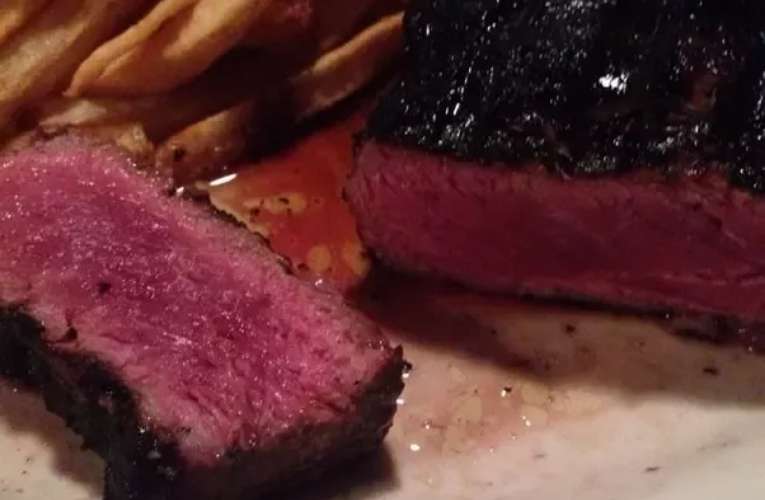A black and blue steak is a culinary term used to describe a style of cooking a steak that involves quickly searing the outside while leaving the interior rare or even raw. The result is a steak with a charred, blackened crust and a cool, blue or rare center.
This cooking method is popular among steak enthusiasts who appreciate the contrast between the crispy exterior and the tender, juicy interior of the meat. It is a bold and flavorful way to enjoy a steak that retains its natural juices and flavors.
Unleashing the Flavors: The Art of Seasoning Black and Blue Steaks
When it comes to cooking the perfect steak, seasoning plays a vital role in enhancing the flavor profile of the meat. Whether you prefer your steak black and blue or cooked to perfection, understanding the art of seasoning is key to creating a mouth-watering masterpiece.
In this section, we will explore the techniques and ingredients used to season black and blue steaks and unleash a symphony of flavors on your taste buds.
1. Choosing the Right Cut:
Before diving into the world of seasoning, it’s important to start with a quality cut of beef. For black and blue steaks, a tender and well-marbled cut such as ribeye or New York strip is ideal. The marbling in the meat not only adds flavor but also helps to keep the steak juicy and tender during the cooking process.
2. Salt, Pepper, and Beyond:
While salt and pepper are the classic seasonings for steaks, black and blue steaks can benefit from additional flavors. Experimenting with a variety of herbs and spices can elevate the taste profile of your steak.
Some popular options include garlic powder, paprika, thyme, rosemary, and cayenne pepper. Don’t be afraid to get creative and customize the seasoning blend to your liking.
3. Preparing the Steak:
Before applying the seasoning, ensure that the steak is at room temperature. This allows for even cooking and enhances the flavor absorption. Pat the steak dry with a paper towel to remove any excess moisture, as this can prevent proper searing and caramelization of the meat.
4. Seasoning Techniques:
When it comes to seasoning black and blue steaks, there are two main techniques to consider:
- Dry Rub: A dry rub involves coating the steak with a mixture of salt, pepper, herbs, and spices. Pat the seasoning blend onto both sides of the steak, ensuring even coverage. Allow the steak to sit for at least 30 minutes to allow the flavors to penetrate the meat.
- Marinade: If you prefer a more intense flavor, marinating the steak can be a great option. Create a marinade using ingredients such as soy sauce, Worcestershire sauce, garlic, and herbs. Place the steak in a Ziploc bag or a shallow dish and let it marinate in the refrigerator for a minimum of 1 hour, or overnight for maximum flavor.
5. Cooking the Perfect Black and Blue Steak:
Once the steak is properly seasoned, it’s time to cook it to perfection. To achieve the desired black and blue result, follow these steps:
- Preheat: Preheat your grill or skillet to high heat to ensure a nice sear on the steak.
- Sear: Place the steak on the hot grill or skillet and cook for approximately 1-2 minutes per side. This quick sear will create a crispy crust while leaving the center rare.
- Rest: Allow the steak to rest for a few minutes before slicing. This helps redistribute the juices and ensures a tender and juicy final result.
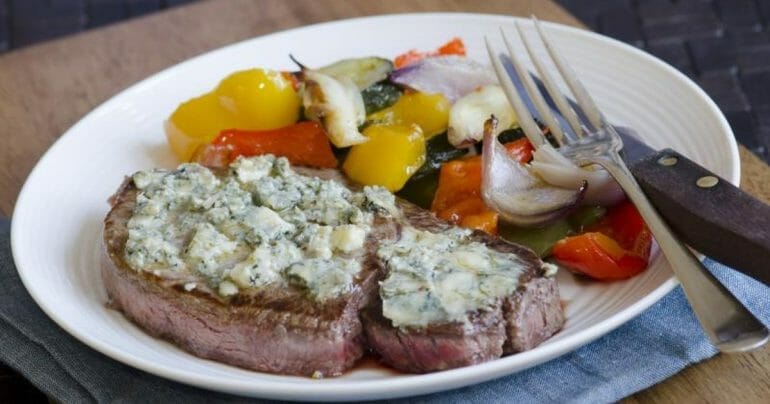
Searing Techniques: Mastering the Art of Achieving a Beautifully Charred Crust
When it comes to cooking meat, achieving a perfectly seared crust is often the mark of a skilled chef. The process of searing involves browning the surface of the meat at a high temperature, resulting in a beautiful caramelization and the development of complex flavors.
In this section, we will explore different techniques to help you master the art of searing and create dishes with a beautifully charred crust.
1. Preparing the Meat
Before you begin the searing process, it’s important to properly prepare the meat. Start by choosing a high-quality cut of meat, such as a ribeye steak or a pork chop. Season the meat generously with salt and pepper, allowing it to sit at room temperature for about 30 minutes to ensure even cooking.
2. Choosing the Right Cooking Surface
The cooking surface plays a crucial role in achieving a perfect sear. Cast iron skillets and stainless steel pans are excellent choices as they retain heat well and provide even heat distribution. Make sure the cooking surface is preheated to a high temperature before adding the meat.
3. Heating the Pan
Heat the pan over medium-high heat until it is smoking hot. This ensures that the meat will immediately sear when it comes into contact with the surface, creating a flavorful crust. Adding a small amount of oil with a high smoke point, such as canola or vegetable oil, can help prevent sticking and aid in achieving a nice sear.
4. Searing the Meat
Carefully place the meat onto the hot cooking surface. Do not overcrowd the pan, as this can reduce the temperature and prevent proper searing. Allow the meat to sear undisturbed for a few minutes until a golden brown crust forms. Flip the meat using tongs and sear the other side for an equal amount of time.
5. Resting the Meat
Once the searing process is complete, remove the meat from the pan and allow it to rest for a few minutes before serving. This allows the juices to redistribute, resulting in a tender and juicy final product.
6. Adding Flavor with Deglazing
After searing the meat, you can take the flavor to the next level by deglazing the pan. Deglazing involves adding a liquid, such as wine or stock, to the hot pan and scraping up the browned bits that have stuck to the surface.
This flavorful liquid can then be used as a base for sauces or gravies to accompany your dish.
7. Searing Beyond Meat
Searing is not limited to just meat. Vegetables such as mushrooms or tofu can also benefit from this technique to add depth and flavor. Just like with meat, ensure that the surface of the vegetables or tofu is dry before adding to the hot pan to achieve a nice sear.

Pairing the Perfect Sides: Complementing the Intense Flavor of Black and Blue Steaks
Black and blue steaks are known for their intense flavor and boldness. The seared exterior and rare, juicy center create a mouthwatering experience that is hard to beat.
To truly enhance the flavors of these steaks, it’s important to pair them with the perfect sides. In this section, we will explore a variety of side dishes that will complement the rich taste of black and blue steaks.
1. Roasted Garlic Mashed Potatoes
Mashed potatoes are a classic side dish that pairs well with many different types of steak. However, when it comes to black and blue steaks, opting for roasted garlic mashed potatoes takes this side dish to a whole new level.
The robust and savory flavors of the garlic perfectly complement the intense flavor of the steak. The creamy texture of the mashed potatoes also helps to balance out the richness of the meat.
2. Grilled Asparagus
For a lighter side dish option that still packs a punch in terms of flavor, grilled asparagus is an excellent choice. The smokiness from the grill adds a nice charred taste to the asparagus, which complements the boldness of the black and blue steak.
Asparagus also provides a refreshing contrast to the richness of the meat, making it a well-rounded accompaniment.
3. Blue Cheese Salad
If you want to highlight the blue cheese element of your black and blue steak, a blue cheese salad is the perfect side dish. The tanginess and creaminess of the blue cheese perfectly balance the intense flavors of the steak.
Crisp lettuce, tomatoes, and other fresh vegetables add a refreshing element to the dish, creating a delightful contrast of textures.
4. Sautéed Mushrooms
Mushrooms have a natural umami flavor that pairs exceptionally well with black and blue steaks. Sautéing them in butter and garlic enhances their earthy taste and adds depth to the dish.
The juicy and tender mushrooms provide a satisfying bite alongside the steak, making them an ideal side dish to complement the intense flavors.
5. Truffle Fries
For a decadent and indulgent side dish, truffle fries are a match made in heaven for black and blue steaks.
The earthy and distinct flavor of truffle oil elevates the taste of the fries, making them a luxurious accompaniment to the intense flavors of the steak. The crispy exterior and fluffy interior of the fries provide a delightful contrast to the tender meat.
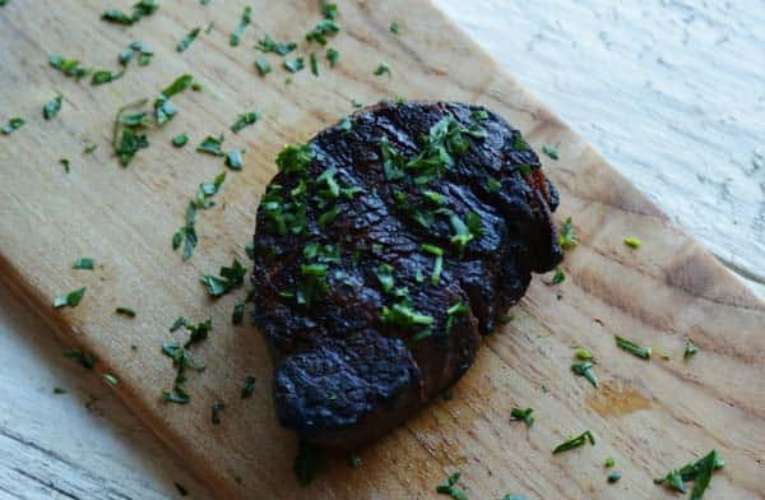
Tips and Tricks: Expert Secrets for Cooking the Ideal Black and Blue Steak
Nothing beats the satisfaction of sinking your teeth into a perfectly cooked Black and Blue steak. This culinary masterpiece, also known as Pittsburgh Rare, combines a charred exterior with a rare or blue-rare interior, resulting in a flavor explosion that will leave your taste buds begging for more.
If you’re ready to take your steak-cooking skills to the next level, here are some expert tips and tricks to help you achieve the ideal Black and Blue steak.
1. Choose the Right Cut of Meat
The key to cooking a delicious Black and Blue steak starts with selecting the right cut of meat. Look for a thick and well-marbled cut like ribeye or New York strip. The marbling not only adds flavor but also helps to keep the steak tender and juicy during cooking.
2. Prepping the Steak
Before you start cooking, make sure your steak is at room temperature. This allows for more even cooking. Pat the steak dry with a paper towel to remove any excess moisture, which can interfere with achieving a proper sear.
Season the steak generously with salt and pepper on both sides, ensuring that the flavors penetrate the meat.
3. Get the Pan Smoking Hot
For the perfect Black and Blue steak, you’ll need a smoking hot cast-iron skillet or grill pan. Preheat the pan over high heat until it starts to smoke. This high heat is essential for achieving a beautiful char on the exterior of the steak.
4. Searing and Timing
Carefully place the seasoned steak onto the hot pan. Allow it to sear for about 1 minute on each side, ensuring a caramelized crust forms. Keep in mind that the interior should remain rare or blue-rare, so be mindful of the timing. For a thinner steak, reduce the searing time to 30 seconds on each side.
5. Resting and Serving
Once the steak is cooked to perfection, remove it from the pan and let it rest for a few minutes. This allows the juices to redistribute, resulting in a more flavorful and tender steak.
Slice the steak against the grain and serve it immediately. Black and Blue steak pairs exceptionally well with a side of crispy fries or a fresh salad.
6. Experiment with Flavors
While the classic Black and Blue steak is divine on its own, don’t be afraid to experiment with different flavors. Consider adding a pat of compound butter or a drizzle of balsamic reduction to enhance the taste.
You can also pair your steak with a tangy chimichurri sauce or a creamy blue cheese dressing for an extra kick.
7. Practice Makes Perfect
Mastering the art of cooking the ideal Black and Blue steak takes practice. Don’t be discouraged if your first attempts don’t turn out exactly as planned. Take note of the timing and adjust it accordingly for your next try.
With patience and persistence, you’ll soon become a Black and Blue steak aficionado.
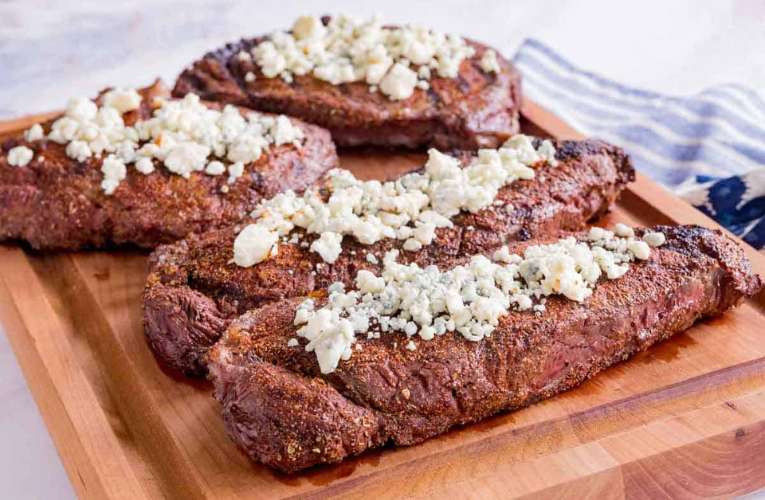
FAQs
What is a black and blue steak?
A black and blue steak, also known as Pittsburgh rare or rare plus, is a style of cooking steak where the outside is charred or seared at high heat, while the inside remains rare or even raw. The result is a steak that is dark on the outside, almost black, but still tender and juicy on the inside.
Conclusion:
In conclusion, the concept of a black and blue steak is a unique and bold variation in the world of cooking. This style of cooking involves searing the outside of the steak at high temperatures, resulting in a blackened crust, while maintaining a rare or blue interior.
The visual contrast between the dark exterior and the tender, juicy center creates an enticing presentation that is sure to wow food enthusiasts.
With its intense flavor and texture, a black and blue steak offers a delightful culinary experience that is perfect for those who appreciate the art of cooking and the enjoyment of a perfectly cooked piece of meat.

